ADOLESCENCE. ADOLESCENCE. 3. 3. : ADOLESCENCE. ADOLESCE
VerifiedAdded on 2022/11/14
|8
|1611
|67
AI Summary
Contribute Materials
Your contribution can guide someone’s learning journey. Share your
documents today.

Running head: ADOLESCENCE
ADOLESCENCE
Name of the Student:
Name of the University:
Author Note:
ADOLESCENCE
Name of the Student:
Name of the University:
Author Note:
Secure Best Marks with AI Grader
Need help grading? Try our AI Grader for instant feedback on your assignments.
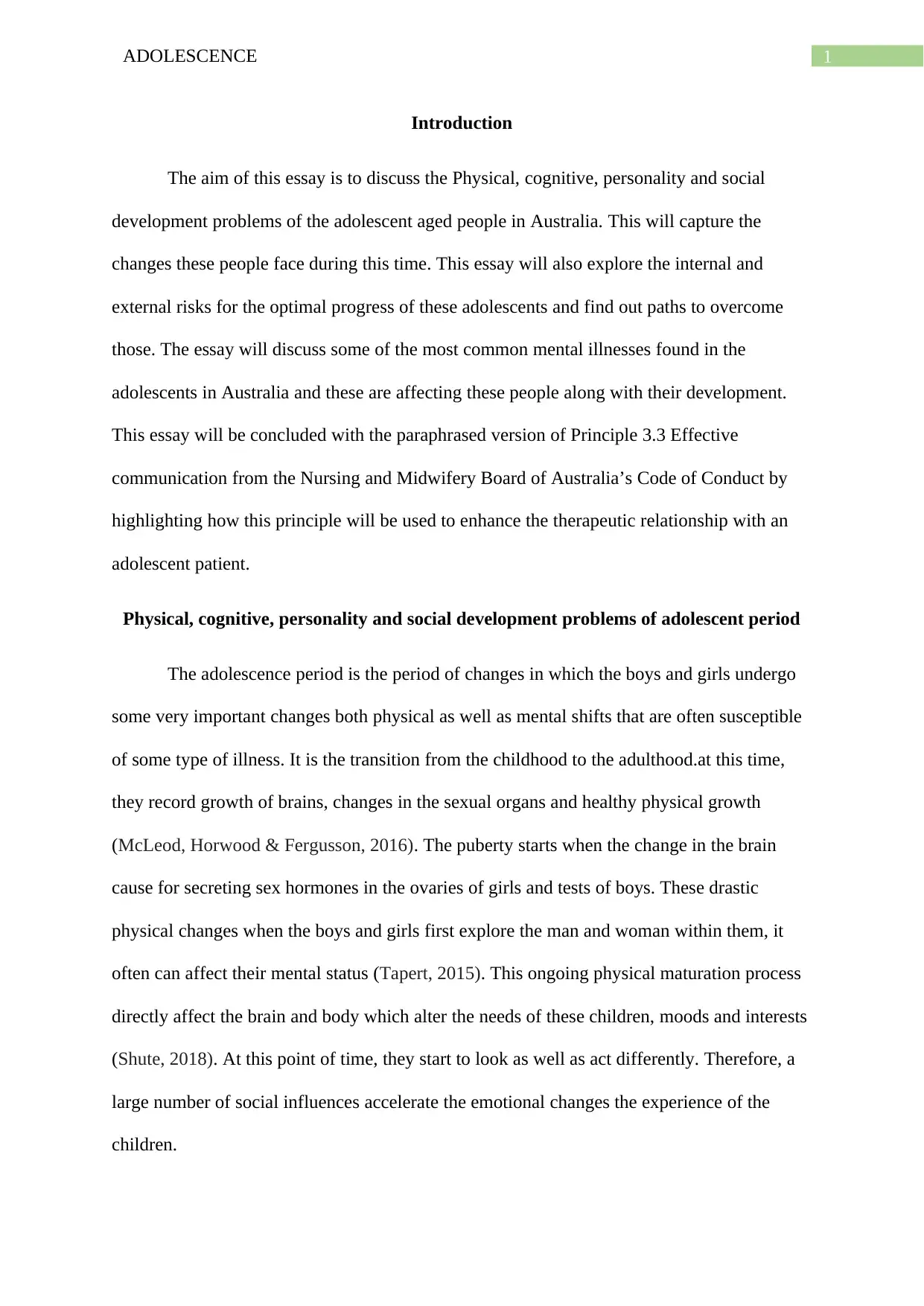
1ADOLESCENCE
Introduction
The aim of this essay is to discuss the Physical, cognitive, personality and social
development problems of the adolescent aged people in Australia. This will capture the
changes these people face during this time. This essay will also explore the internal and
external risks for the optimal progress of these adolescents and find out paths to overcome
those. The essay will discuss some of the most common mental illnesses found in the
adolescents in Australia and these are affecting these people along with their development.
This essay will be concluded with the paraphrased version of Principle 3.3 Effective
communication from the Nursing and Midwifery Board of Australia’s Code of Conduct by
highlighting how this principle will be used to enhance the therapeutic relationship with an
adolescent patient.
Physical, cognitive, personality and social development problems of adolescent period
The adolescence period is the period of changes in which the boys and girls undergo
some very important changes both physical as well as mental shifts that are often susceptible
of some type of illness. It is the transition from the childhood to the adulthood.at this time,
they record growth of brains, changes in the sexual organs and healthy physical growth
(McLeod, Horwood & Fergusson, 2016). The puberty starts when the change in the brain
cause for secreting sex hormones in the ovaries of girls and tests of boys. These drastic
physical changes when the boys and girls first explore the man and woman within them, it
often can affect their mental status (Tapert, 2015). This ongoing physical maturation process
directly affect the brain and body which alter the needs of these children, moods and interests
(Shute, 2018). At this point of time, they start to look as well as act differently. Therefore, a
large number of social influences accelerate the emotional changes the experience of the
children.
Introduction
The aim of this essay is to discuss the Physical, cognitive, personality and social
development problems of the adolescent aged people in Australia. This will capture the
changes these people face during this time. This essay will also explore the internal and
external risks for the optimal progress of these adolescents and find out paths to overcome
those. The essay will discuss some of the most common mental illnesses found in the
adolescents in Australia and these are affecting these people along with their development.
This essay will be concluded with the paraphrased version of Principle 3.3 Effective
communication from the Nursing and Midwifery Board of Australia’s Code of Conduct by
highlighting how this principle will be used to enhance the therapeutic relationship with an
adolescent patient.
Physical, cognitive, personality and social development problems of adolescent period
The adolescence period is the period of changes in which the boys and girls undergo
some very important changes both physical as well as mental shifts that are often susceptible
of some type of illness. It is the transition from the childhood to the adulthood.at this time,
they record growth of brains, changes in the sexual organs and healthy physical growth
(McLeod, Horwood & Fergusson, 2016). The puberty starts when the change in the brain
cause for secreting sex hormones in the ovaries of girls and tests of boys. These drastic
physical changes when the boys and girls first explore the man and woman within them, it
often can affect their mental status (Tapert, 2015). This ongoing physical maturation process
directly affect the brain and body which alter the needs of these children, moods and interests
(Shute, 2018). At this point of time, they start to look as well as act differently. Therefore, a
large number of social influences accelerate the emotional changes the experience of the
children.
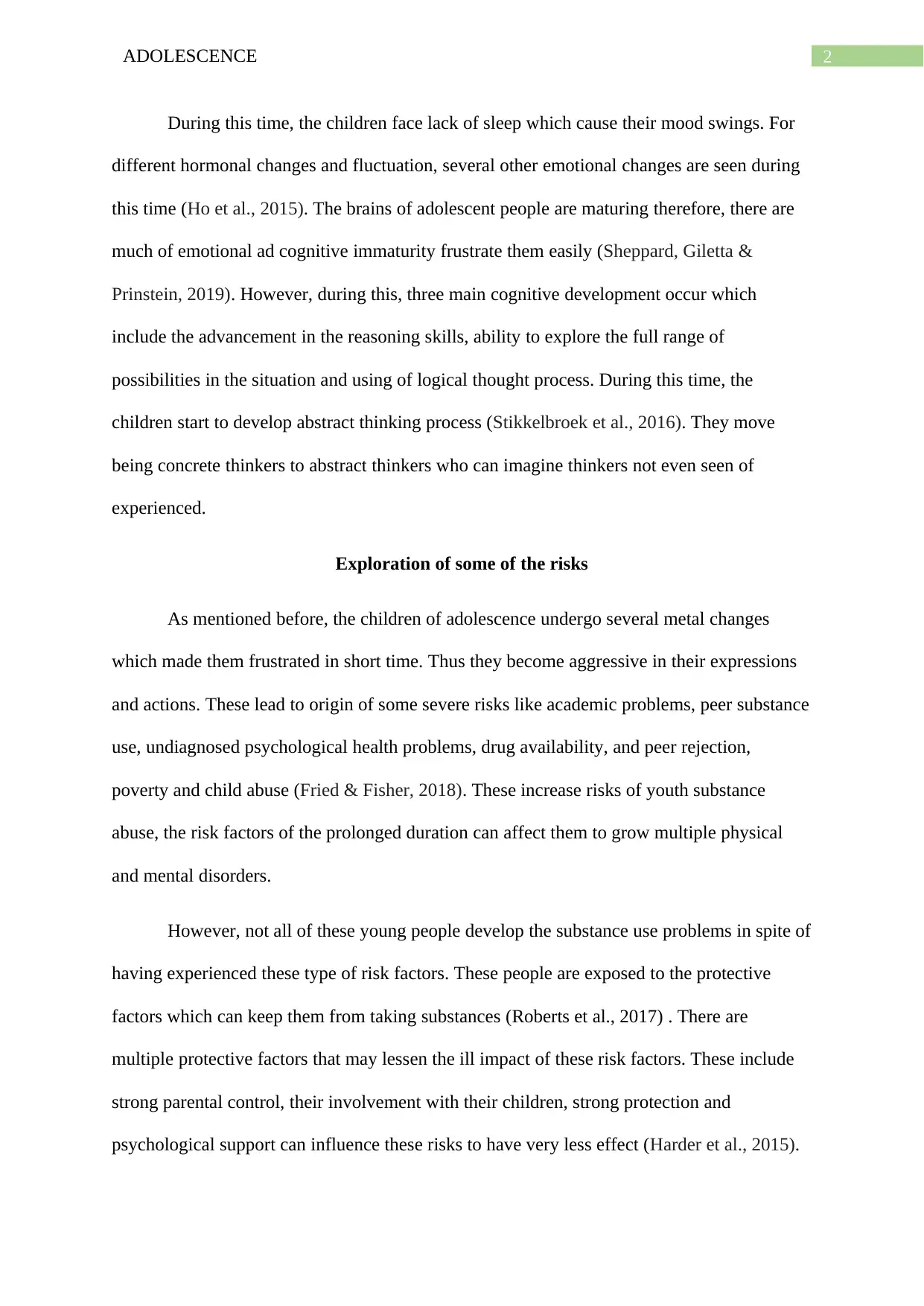
2ADOLESCENCE
During this time, the children face lack of sleep which cause their mood swings. For
different hormonal changes and fluctuation, several other emotional changes are seen during
this time (Ho et al., 2015). The brains of adolescent people are maturing therefore, there are
much of emotional ad cognitive immaturity frustrate them easily (Sheppard, Giletta &
Prinstein, 2019). However, during this, three main cognitive development occur which
include the advancement in the reasoning skills, ability to explore the full range of
possibilities in the situation and using of logical thought process. During this time, the
children start to develop abstract thinking process (Stikkelbroek et al., 2016). They move
being concrete thinkers to abstract thinkers who can imagine thinkers not even seen of
experienced.
Exploration of some of the risks
As mentioned before, the children of adolescence undergo several metal changes
which made them frustrated in short time. Thus they become aggressive in their expressions
and actions. These lead to origin of some severe risks like academic problems, peer substance
use, undiagnosed psychological health problems, drug availability, and peer rejection,
poverty and child abuse (Fried & Fisher, 2018). These increase risks of youth substance
abuse, the risk factors of the prolonged duration can affect them to grow multiple physical
and mental disorders.
However, not all of these young people develop the substance use problems in spite of
having experienced these type of risk factors. These people are exposed to the protective
factors which can keep them from taking substances (Roberts et al., 2017) . There are
multiple protective factors that may lessen the ill impact of these risk factors. These include
strong parental control, their involvement with their children, strong protection and
psychological support can influence these risks to have very less effect (Harder et al., 2015).
During this time, the children face lack of sleep which cause their mood swings. For
different hormonal changes and fluctuation, several other emotional changes are seen during
this time (Ho et al., 2015). The brains of adolescent people are maturing therefore, there are
much of emotional ad cognitive immaturity frustrate them easily (Sheppard, Giletta &
Prinstein, 2019). However, during this, three main cognitive development occur which
include the advancement in the reasoning skills, ability to explore the full range of
possibilities in the situation and using of logical thought process. During this time, the
children start to develop abstract thinking process (Stikkelbroek et al., 2016). They move
being concrete thinkers to abstract thinkers who can imagine thinkers not even seen of
experienced.
Exploration of some of the risks
As mentioned before, the children of adolescence undergo several metal changes
which made them frustrated in short time. Thus they become aggressive in their expressions
and actions. These lead to origin of some severe risks like academic problems, peer substance
use, undiagnosed psychological health problems, drug availability, and peer rejection,
poverty and child abuse (Fried & Fisher, 2018). These increase risks of youth substance
abuse, the risk factors of the prolonged duration can affect them to grow multiple physical
and mental disorders.
However, not all of these young people develop the substance use problems in spite of
having experienced these type of risk factors. These people are exposed to the protective
factors which can keep them from taking substances (Roberts et al., 2017) . There are
multiple protective factors that may lessen the ill impact of these risk factors. These include
strong parental control, their involvement with their children, strong protection and
psychological support can influence these risks to have very less effect (Harder et al., 2015).
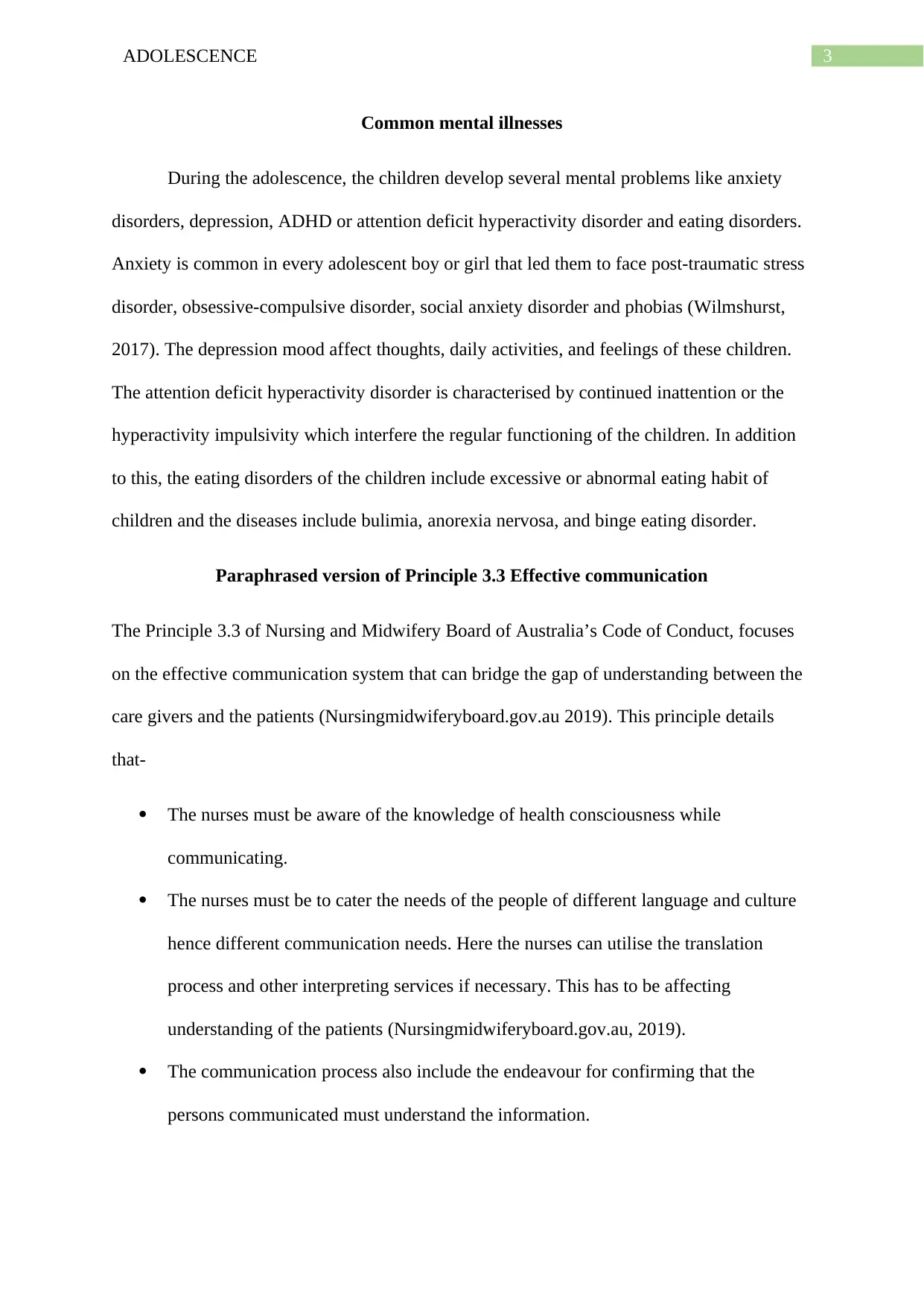
3ADOLESCENCE
Common mental illnesses
During the adolescence, the children develop several mental problems like anxiety
disorders, depression, ADHD or attention deficit hyperactivity disorder and eating disorders.
Anxiety is common in every adolescent boy or girl that led them to face post-traumatic stress
disorder, obsessive-compulsive disorder, social anxiety disorder and phobias (Wilmshurst,
2017). The depression mood affect thoughts, daily activities, and feelings of these children.
The attention deficit hyperactivity disorder is characterised by continued inattention or the
hyperactivity impulsivity which interfere the regular functioning of the children. In addition
to this, the eating disorders of the children include excessive or abnormal eating habit of
children and the diseases include bulimia, anorexia nervosa, and binge eating disorder.
Paraphrased version of Principle 3.3 Effective communication
The Principle 3.3 of Nursing and Midwifery Board of Australia’s Code of Conduct, focuses
on the effective communication system that can bridge the gap of understanding between the
care givers and the patients (Nursingmidwiferyboard.gov.au 2019). This principle details
that-
The nurses must be aware of the knowledge of health consciousness while
communicating.
The nurses must be to cater the needs of the people of different language and culture
hence different communication needs. Here the nurses can utilise the translation
process and other interpreting services if necessary. This has to be affecting
understanding of the patients (Nursingmidwiferyboard.gov.au, 2019).
The communication process also include the endeavour for confirming that the
persons communicated must understand the information.
Common mental illnesses
During the adolescence, the children develop several mental problems like anxiety
disorders, depression, ADHD or attention deficit hyperactivity disorder and eating disorders.
Anxiety is common in every adolescent boy or girl that led them to face post-traumatic stress
disorder, obsessive-compulsive disorder, social anxiety disorder and phobias (Wilmshurst,
2017). The depression mood affect thoughts, daily activities, and feelings of these children.
The attention deficit hyperactivity disorder is characterised by continued inattention or the
hyperactivity impulsivity which interfere the regular functioning of the children. In addition
to this, the eating disorders of the children include excessive or abnormal eating habit of
children and the diseases include bulimia, anorexia nervosa, and binge eating disorder.
Paraphrased version of Principle 3.3 Effective communication
The Principle 3.3 of Nursing and Midwifery Board of Australia’s Code of Conduct, focuses
on the effective communication system that can bridge the gap of understanding between the
care givers and the patients (Nursingmidwiferyboard.gov.au 2019). This principle details
that-
The nurses must be aware of the knowledge of health consciousness while
communicating.
The nurses must be to cater the needs of the people of different language and culture
hence different communication needs. Here the nurses can utilise the translation
process and other interpreting services if necessary. This has to be affecting
understanding of the patients (Nursingmidwiferyboard.gov.au, 2019).
The communication process also include the endeavour for confirming that the
persons communicated must understand the information.
Secure Best Marks with AI Grader
Need help grading? Try our AI Grader for instant feedback on your assignments.
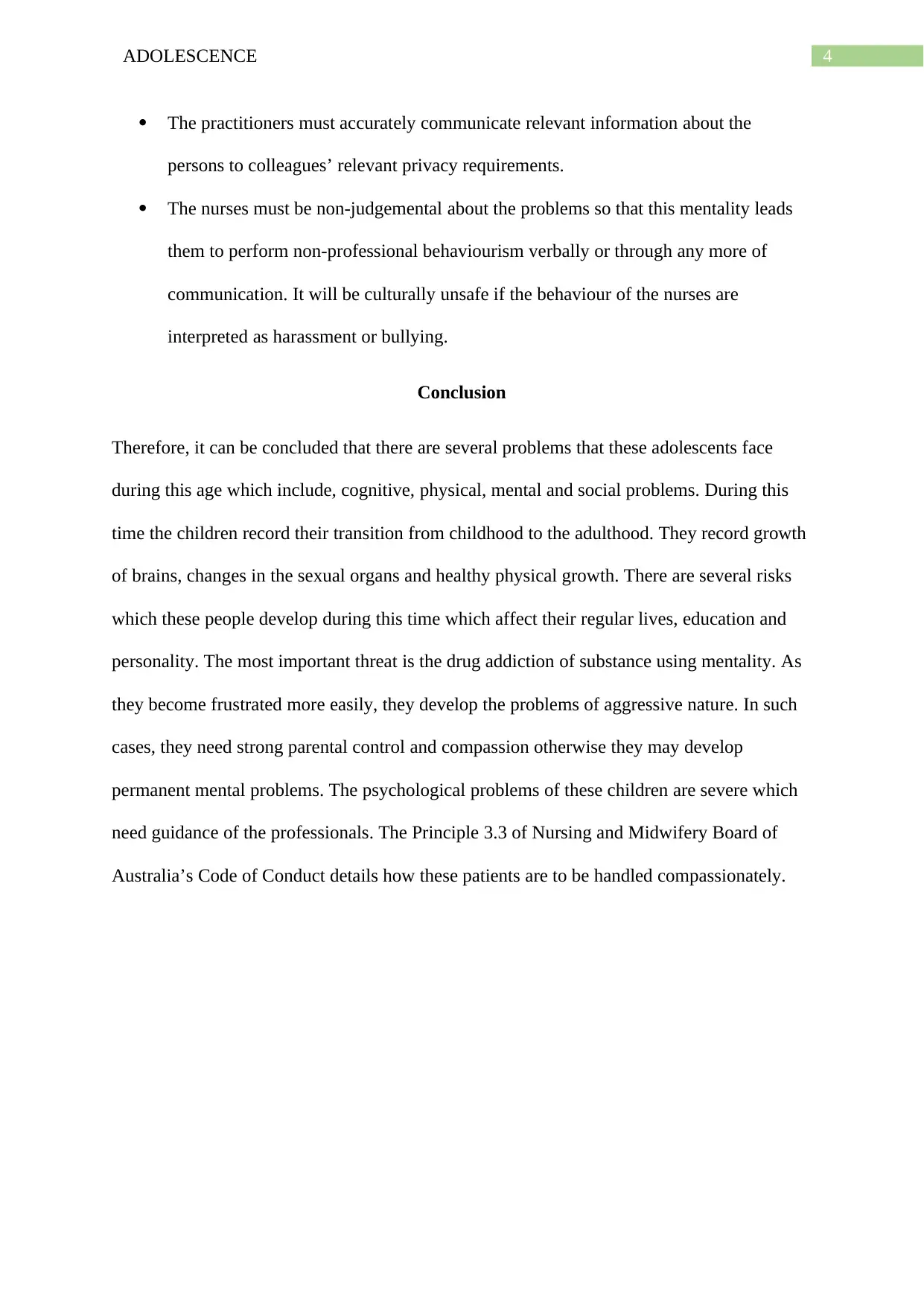
4ADOLESCENCE
The practitioners must accurately communicate relevant information about the
persons to colleagues’ relevant privacy requirements.
The nurses must be non-judgemental about the problems so that this mentality leads
them to perform non-professional behaviourism verbally or through any more of
communication. It will be culturally unsafe if the behaviour of the nurses are
interpreted as harassment or bullying.
Conclusion
Therefore, it can be concluded that there are several problems that these adolescents face
during this age which include, cognitive, physical, mental and social problems. During this
time the children record their transition from childhood to the adulthood. They record growth
of brains, changes in the sexual organs and healthy physical growth. There are several risks
which these people develop during this time which affect their regular lives, education and
personality. The most important threat is the drug addiction of substance using mentality. As
they become frustrated more easily, they develop the problems of aggressive nature. In such
cases, they need strong parental control and compassion otherwise they may develop
permanent mental problems. The psychological problems of these children are severe which
need guidance of the professionals. The Principle 3.3 of Nursing and Midwifery Board of
Australia’s Code of Conduct details how these patients are to be handled compassionately.
The practitioners must accurately communicate relevant information about the
persons to colleagues’ relevant privacy requirements.
The nurses must be non-judgemental about the problems so that this mentality leads
them to perform non-professional behaviourism verbally or through any more of
communication. It will be culturally unsafe if the behaviour of the nurses are
interpreted as harassment or bullying.
Conclusion
Therefore, it can be concluded that there are several problems that these adolescents face
during this age which include, cognitive, physical, mental and social problems. During this
time the children record their transition from childhood to the adulthood. They record growth
of brains, changes in the sexual organs and healthy physical growth. There are several risks
which these people develop during this time which affect their regular lives, education and
personality. The most important threat is the drug addiction of substance using mentality. As
they become frustrated more easily, they develop the problems of aggressive nature. In such
cases, they need strong parental control and compassion otherwise they may develop
permanent mental problems. The psychological problems of these children are severe which
need guidance of the professionals. The Principle 3.3 of Nursing and Midwifery Board of
Australia’s Code of Conduct details how these patients are to be handled compassionately.

5ADOLESCENCE
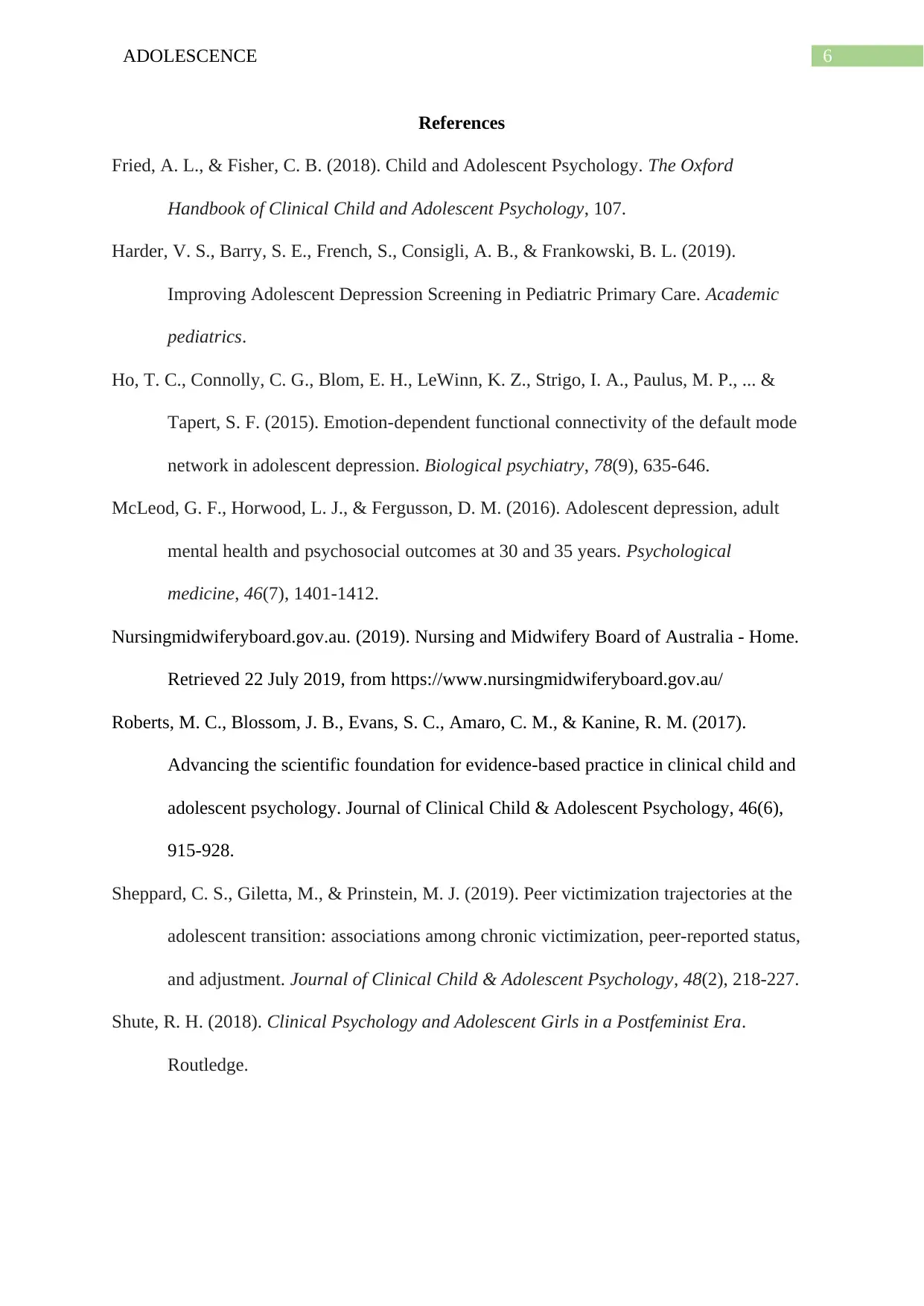
6ADOLESCENCE
References
Fried, A. L., & Fisher, C. B. (2018). Child and Adolescent Psychology. The Oxford
Handbook of Clinical Child and Adolescent Psychology, 107.
Harder, V. S., Barry, S. E., French, S., Consigli, A. B., & Frankowski, B. L. (2019).
Improving Adolescent Depression Screening in Pediatric Primary Care. Academic
pediatrics.
Ho, T. C., Connolly, C. G., Blom, E. H., LeWinn, K. Z., Strigo, I. A., Paulus, M. P., ... &
Tapert, S. F. (2015). Emotion-dependent functional connectivity of the default mode
network in adolescent depression. Biological psychiatry, 78(9), 635-646.
McLeod, G. F., Horwood, L. J., & Fergusson, D. M. (2016). Adolescent depression, adult
mental health and psychosocial outcomes at 30 and 35 years. Psychological
medicine, 46(7), 1401-1412.
Nursingmidwiferyboard.gov.au. (2019). Nursing and Midwifery Board of Australia - Home.
Retrieved 22 July 2019, from https://www.nursingmidwiferyboard.gov.au/
Roberts, M. C., Blossom, J. B., Evans, S. C., Amaro, C. M., & Kanine, R. M. (2017).
Advancing the scientific foundation for evidence-based practice in clinical child and
adolescent psychology. Journal of Clinical Child & Adolescent Psychology, 46(6),
915-928.
Sheppard, C. S., Giletta, M., & Prinstein, M. J. (2019). Peer victimization trajectories at the
adolescent transition: associations among chronic victimization, peer-reported status,
and adjustment. Journal of Clinical Child & Adolescent Psychology, 48(2), 218-227.
Shute, R. H. (2018). Clinical Psychology and Adolescent Girls in a Postfeminist Era.
Routledge.
References
Fried, A. L., & Fisher, C. B. (2018). Child and Adolescent Psychology. The Oxford
Handbook of Clinical Child and Adolescent Psychology, 107.
Harder, V. S., Barry, S. E., French, S., Consigli, A. B., & Frankowski, B. L. (2019).
Improving Adolescent Depression Screening in Pediatric Primary Care. Academic
pediatrics.
Ho, T. C., Connolly, C. G., Blom, E. H., LeWinn, K. Z., Strigo, I. A., Paulus, M. P., ... &
Tapert, S. F. (2015). Emotion-dependent functional connectivity of the default mode
network in adolescent depression. Biological psychiatry, 78(9), 635-646.
McLeod, G. F., Horwood, L. J., & Fergusson, D. M. (2016). Adolescent depression, adult
mental health and psychosocial outcomes at 30 and 35 years. Psychological
medicine, 46(7), 1401-1412.
Nursingmidwiferyboard.gov.au. (2019). Nursing and Midwifery Board of Australia - Home.
Retrieved 22 July 2019, from https://www.nursingmidwiferyboard.gov.au/
Roberts, M. C., Blossom, J. B., Evans, S. C., Amaro, C. M., & Kanine, R. M. (2017).
Advancing the scientific foundation for evidence-based practice in clinical child and
adolescent psychology. Journal of Clinical Child & Adolescent Psychology, 46(6),
915-928.
Sheppard, C. S., Giletta, M., & Prinstein, M. J. (2019). Peer victimization trajectories at the
adolescent transition: associations among chronic victimization, peer-reported status,
and adjustment. Journal of Clinical Child & Adolescent Psychology, 48(2), 218-227.
Shute, R. H. (2018). Clinical Psychology and Adolescent Girls in a Postfeminist Era.
Routledge.
Paraphrase This Document
Need a fresh take? Get an instant paraphrase of this document with our AI Paraphraser
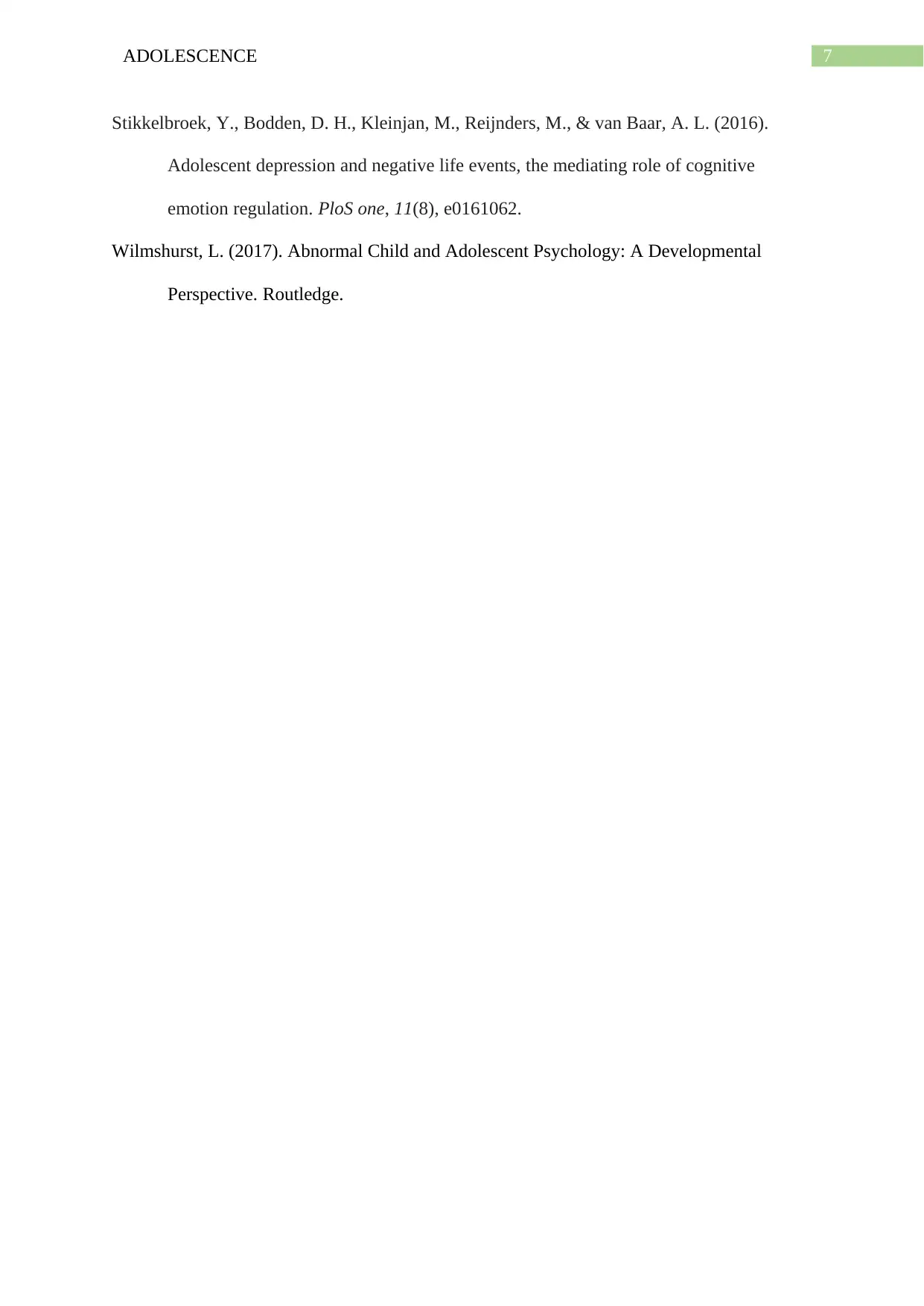
7ADOLESCENCE
Stikkelbroek, Y., Bodden, D. H., Kleinjan, M., Reijnders, M., & van Baar, A. L. (2016).
Adolescent depression and negative life events, the mediating role of cognitive
emotion regulation. PloS one, 11(8), e0161062.
Wilmshurst, L. (2017). Abnormal Child and Adolescent Psychology: A Developmental
Perspective. Routledge.
Stikkelbroek, Y., Bodden, D. H., Kleinjan, M., Reijnders, M., & van Baar, A. L. (2016).
Adolescent depression and negative life events, the mediating role of cognitive
emotion regulation. PloS one, 11(8), e0161062.
Wilmshurst, L. (2017). Abnormal Child and Adolescent Psychology: A Developmental
Perspective. Routledge.
1 out of 8
Related Documents
Your All-in-One AI-Powered Toolkit for Academic Success.
+13062052269
info@desklib.com
Available 24*7 on WhatsApp / Email
![[object Object]](/_next/static/media/star-bottom.7253800d.svg)
Unlock your academic potential
© 2024 | Zucol Services PVT LTD | All rights reserved.




